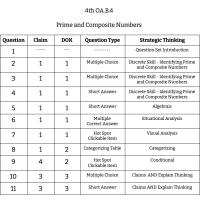
4th Grade Math - OA.B.4 - Prime and Composite Numbers
11 Questions
Prime and Composite Numbers Introduction
Identify the prime number.
Which of these numbers is composite?
How many prime numbers are there between 20 and 30? Identify them.
Find two different composite numbers that will complete this equation.
Identify TWO equations that show how the product of two prime numbers equals a composite number.
Click on the image that is modeling a prime number.
Identify each number as prime or composite.
Click on a number that meets all of the conditions below.
Enrique claims that all composite numbers have at least 4 factors. Do you support his claim? Explain.
Selena claims that the sum of two prime numbers is always composite. Do you support Selena's claim? Explain using examples.

We help districts in California boost CAASPP Math Scores by Δ +20% by helping teachers determine if students are struggling with the content, the technology involved with the type of question, or the type of strategic thinking required. Based on the 8 Standards for Mathematical Practice, our platform and professional development empowers teachers to recognize all 16 types of strategic thinking across any math question, curriculum, or assessment.
Learn more